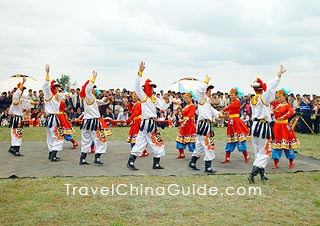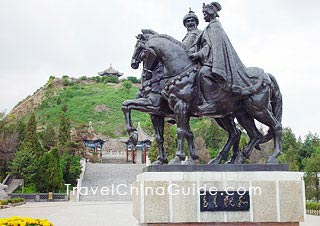Hohhot Travel Guide
Hohhot Facts
Chinese Name: 呼和浩特 (hū hé hào tè)
Population: 3,137,000
Area: 17,200 square kilometers (6,641 square miles)
Location: in the central area of Inner Mongolia, north China
Administrative Division: 4 districts (Yuquan, Huimin, Xincheng, Saihan); 4 counties (Tokto, Horinger, Qingshuihe, Wuchuan); 1 banner (Tolmud Left Banner)
Area Code: 0471
Zip Code: 010000
GDP (2019): CNY 279.15 billion (USD 40.46 billion)
Nationalities: Mongol, Han, Man, Hui, Zang, Daur, Ewenke, Chaoxian
Prosperous Inner Mongolian Capital
Hohhot, the capital of the Inner Mongolia Autonomous Region in northern China, means a green city in Mongolian language. It is adjacent to Baotou and Ordos to the west, Ulanqab to the east and Shanxi to the south. Hohhot is an important Chinese border city open to Mongolia and Russia, and also a key aviation hub in northern China. Besides Tianjin and Shijiazhuang, Hohhot is the nearest provincial capital city to Beijing. As China's two largest dairy suppliers, Yili Group and Mengniu, are headquartered in Hohhot, this city earns the title of Chinese dairy capital. Hohhot also features distinctive Tibetan Buddhist temples and monasteries with ethnic characteristics. The Islamic-style buildings with spherical roof and the towering column towers can be found here. There are also many beautiful grassland tourist spots on the outskirts of the city.![]() Pictures
Pictures ![]() Maps
Maps
- Dazhao Temple
- Gegentala Grassland
- Xilamuren Grassland
- Five-Pagoda Temple
- Xilituzhao Palace
- Zhaojun Museum
|
|
As a tourist resort, Hohhot has a modern reliable transport network. Hohhot Baita (White Pagoda) Airport has direct flights to Ulaanbaatar, Mongolia, Beijing, Shanghai, Guangzhou and other cities. Hohhot Railway Station and East Railway Station have direct train connections with Beijing, Hailar, Baotou, Xi'an, Lanzhou, Yinchuan, Shanghai, Nanjing, Ningbo, plus international trains to Ulan Bator and Moscow. Daily buses link the city with other major cities including Beijing, Tianjin, Taiyuan, Datong, and Baotou. City-bus and taxi are available in Hohhot.
Hohhot Tours
Hiking Adventures Golf Vacation Bicycle Route
Hohhot Travel Tips
![]() History: Hohhot has a long history of over 2300 years. In the period of Warring States (476 BC - 221 BC), Zhaowuhou (340 BC – 295 BC) build the Ancient City. In Northern Wei period (386 – 557), Xianbei ethnic groups established a capital at Horinger County which was the first capital in the north grassland with the historical name of Shile. The city was renamed Fegzhou in Liao period (916 – 1125). In 1581 during Ming Dynasty (1368 – 1644), Tolmud leader Altan Khan constructed a city in Yuquan District, named Hohhot in Mongolian, and later renamed it to Guihua. In 1737 during Qing Dynasty (1644 – 1911), the government built Suiyuan city, a strong garrison town, at the northeast of Guihua, then united the two cites as one naming it Guisui. In 1954, the city became the capital of Inner Mongolia and resumed the name of Hohhot.
History: Hohhot has a long history of over 2300 years. In the period of Warring States (476 BC - 221 BC), Zhaowuhou (340 BC – 295 BC) build the Ancient City. In Northern Wei period (386 – 557), Xianbei ethnic groups established a capital at Horinger County which was the first capital in the north grassland with the historical name of Shile. The city was renamed Fegzhou in Liao period (916 – 1125). In 1581 during Ming Dynasty (1368 – 1644), Tolmud leader Altan Khan constructed a city in Yuquan District, named Hohhot in Mongolian, and later renamed it to Guihua. In 1737 during Qing Dynasty (1644 – 1911), the government built Suiyuan city, a strong garrison town, at the northeast of Guihua, then united the two cites as one naming it Guisui. In 1954, the city became the capital of Inner Mongolia and resumed the name of Hohhot.
![]() Special Local Products: Hohhot brings together specialties from all over Inner Mongolia, ranging from Mongolian silverwares, carpets, cashmere, camel hair products, traditional knives, decorative deer antlers, narrow-leaved oleaster curtain, oatmeal and various dairy products to fancy Mongolian costumes.
Special Local Products: Hohhot brings together specialties from all over Inner Mongolia, ranging from Mongolian silverwares, carpets, cashmere, camel hair products, traditional knives, decorative deer antlers, narrow-leaved oleaster curtain, oatmeal and various dairy products to fancy Mongolian costumes.
![]() Entertainment: Mongolian folk songs and wrestling are popular entertainments while ethnic delicacies and the friendliness of the local people add to the enjoyment of a stay here. Visitors can enjoy a wide variety of activities including horse riding, or maybe visiting the home of a herdsman's family or roaming over the vast grassland and of course there is the thrilling Nadam Fair.
Entertainment: Mongolian folk songs and wrestling are popular entertainments while ethnic delicacies and the friendliness of the local people add to the enjoyment of a stay here. Visitors can enjoy a wide variety of activities including horse riding, or maybe visiting the home of a herdsman's family or roaming over the vast grassland and of course there is the thrilling Nadam Fair.

